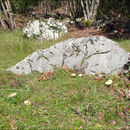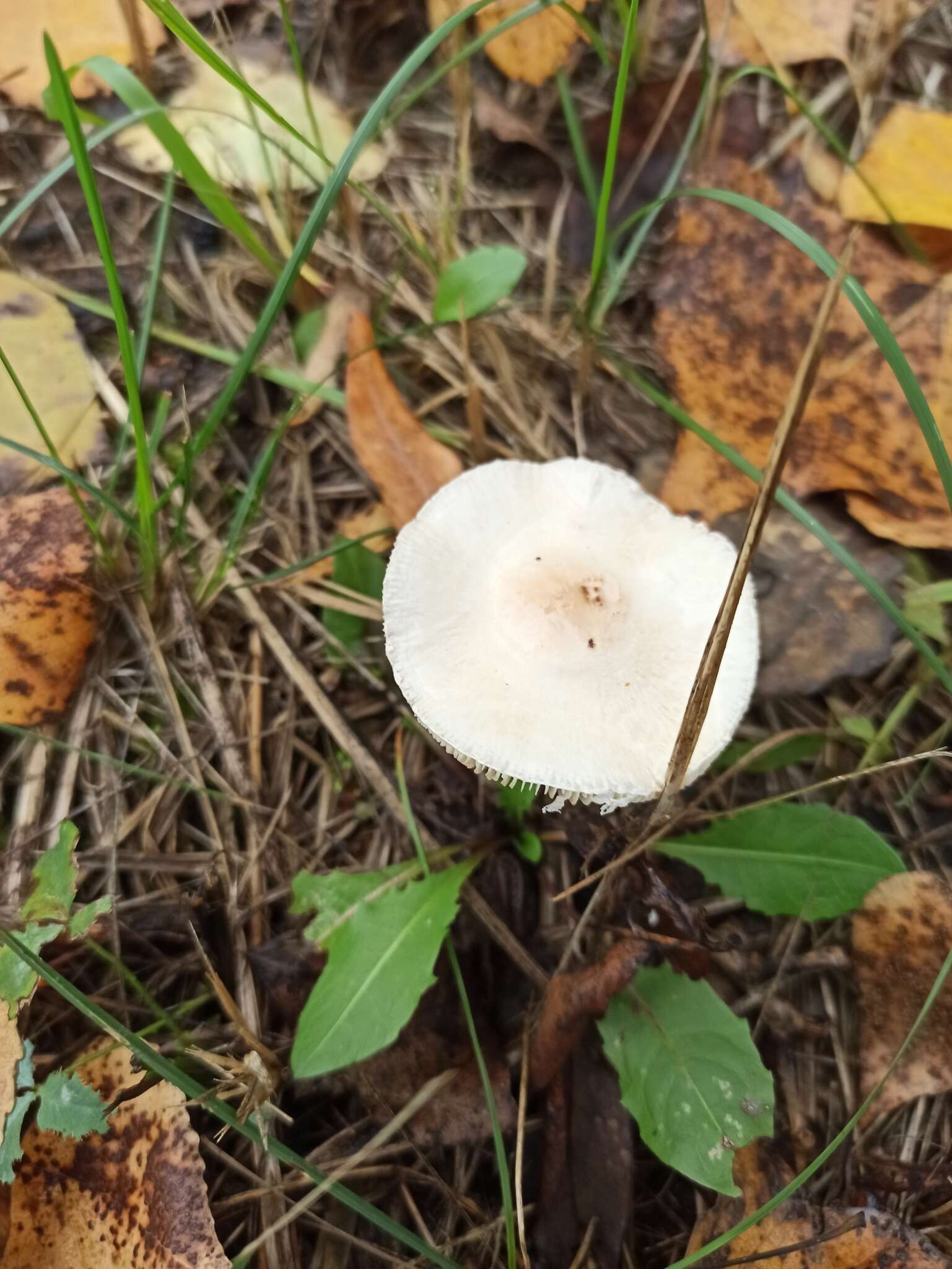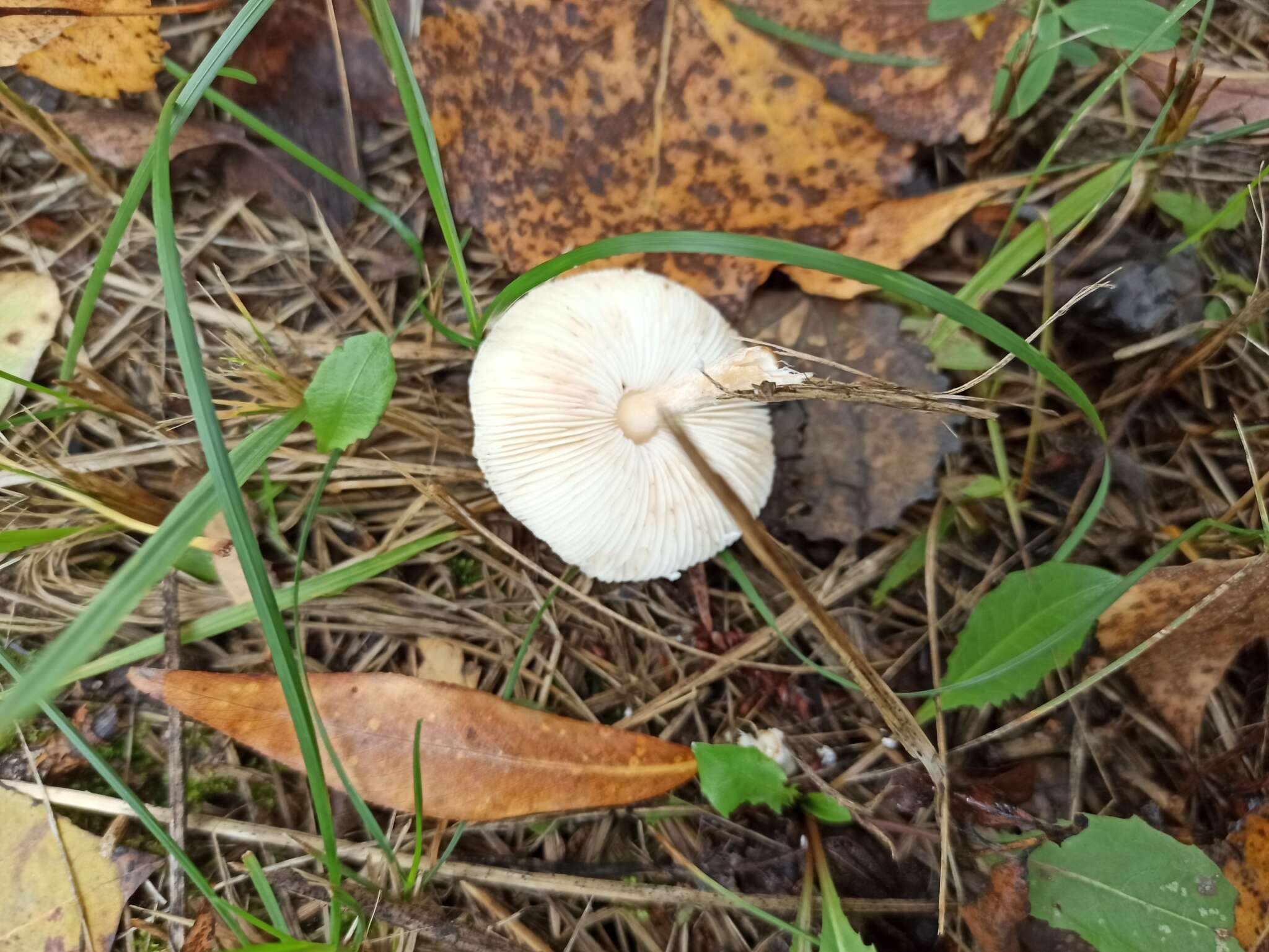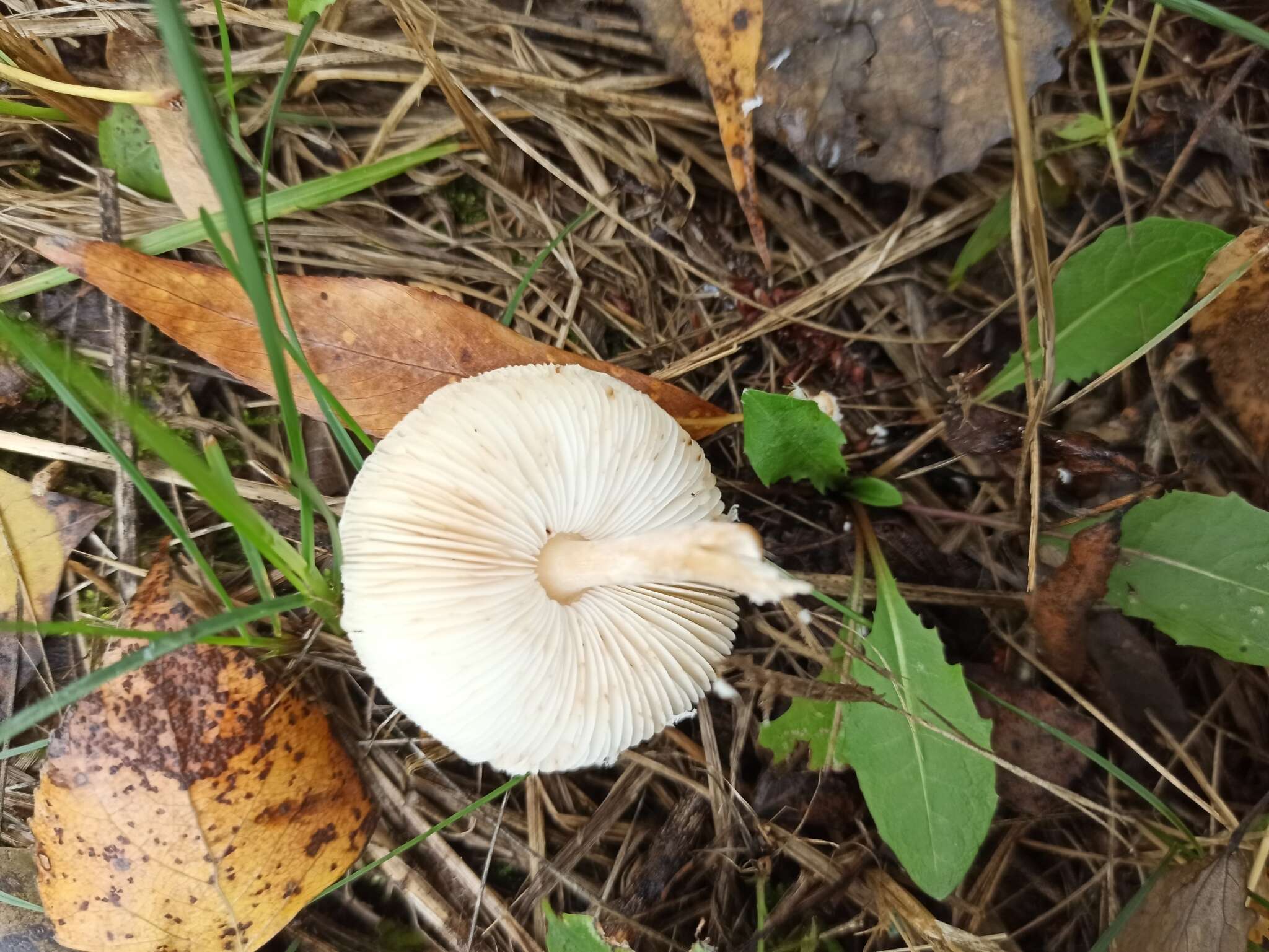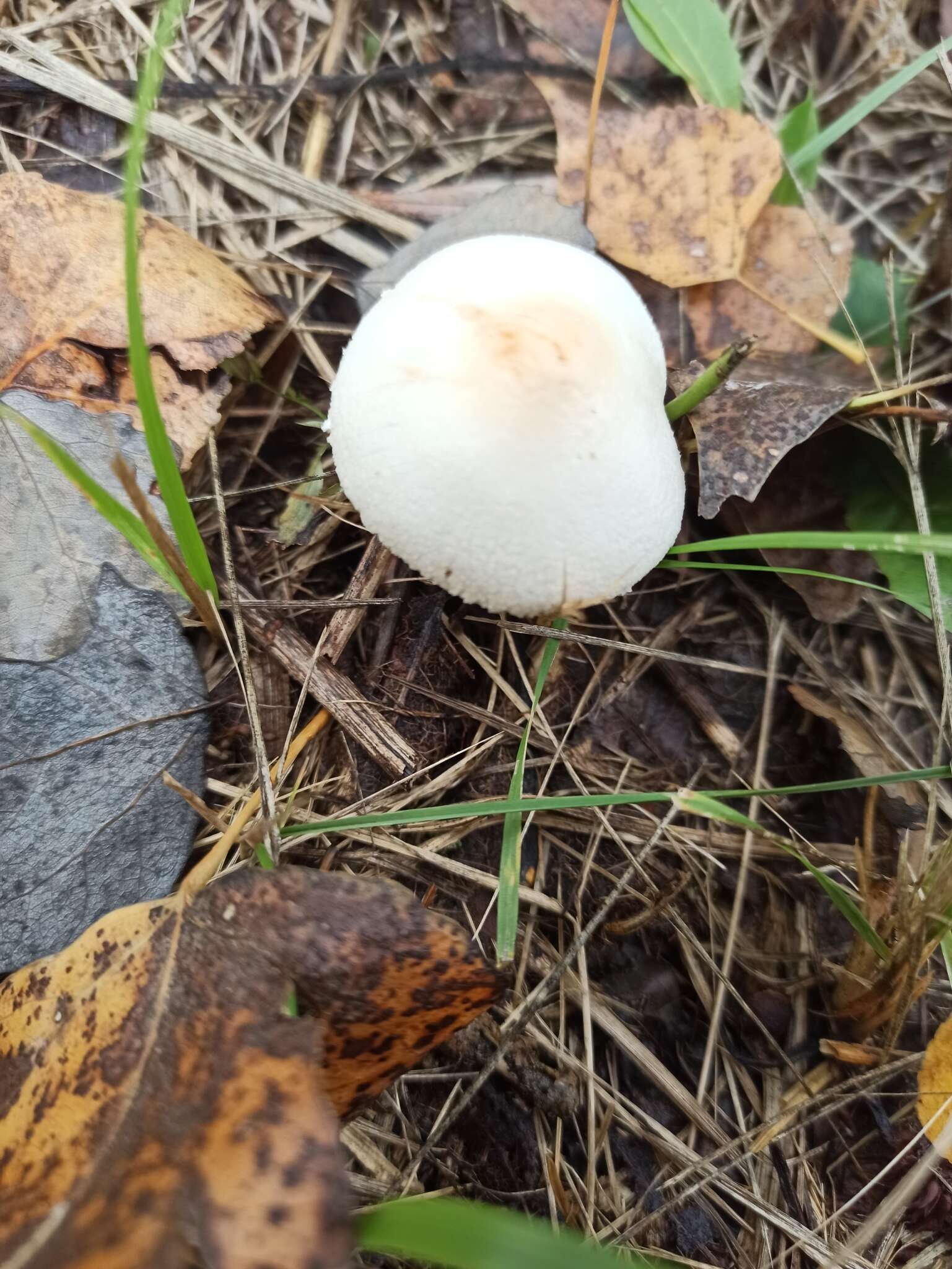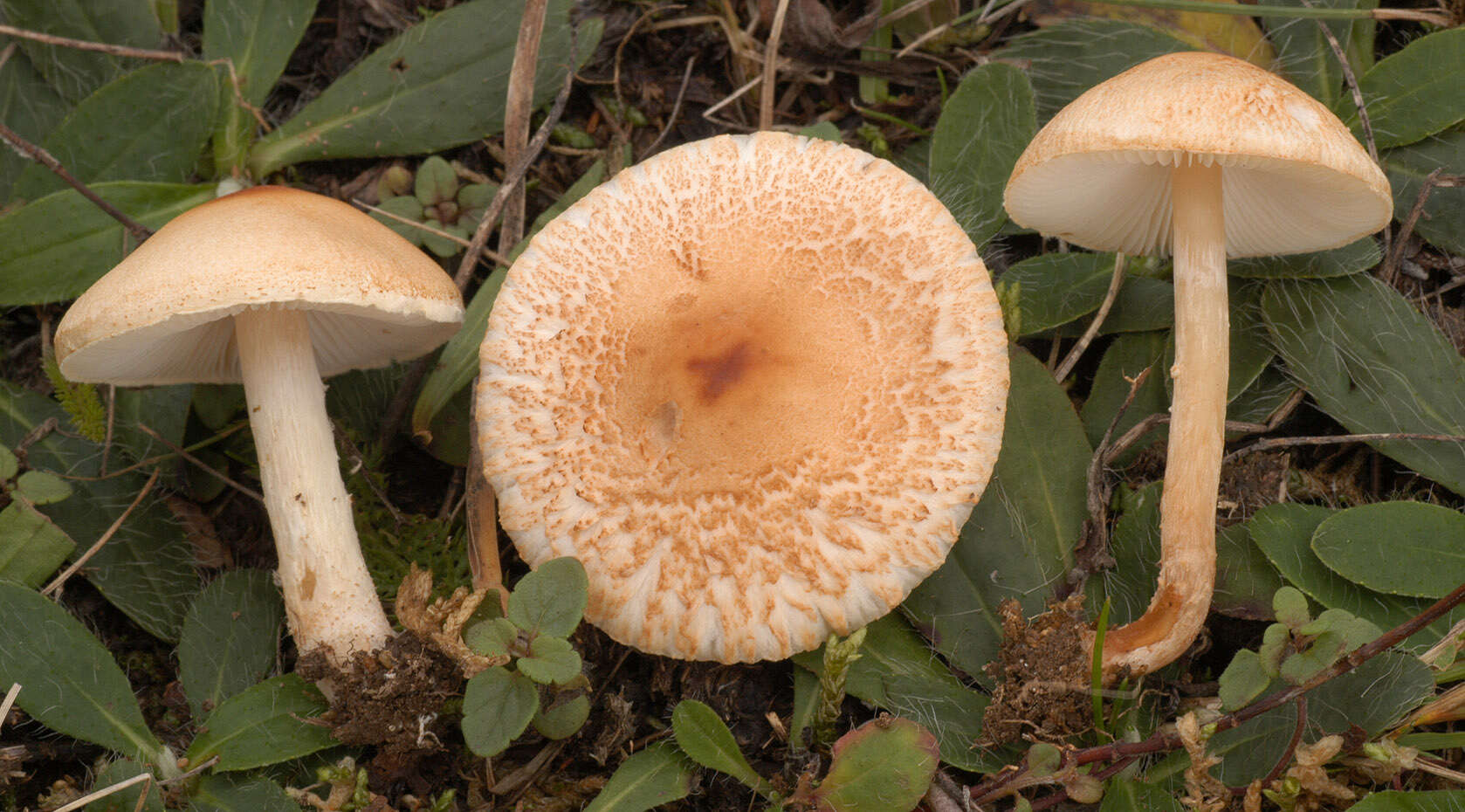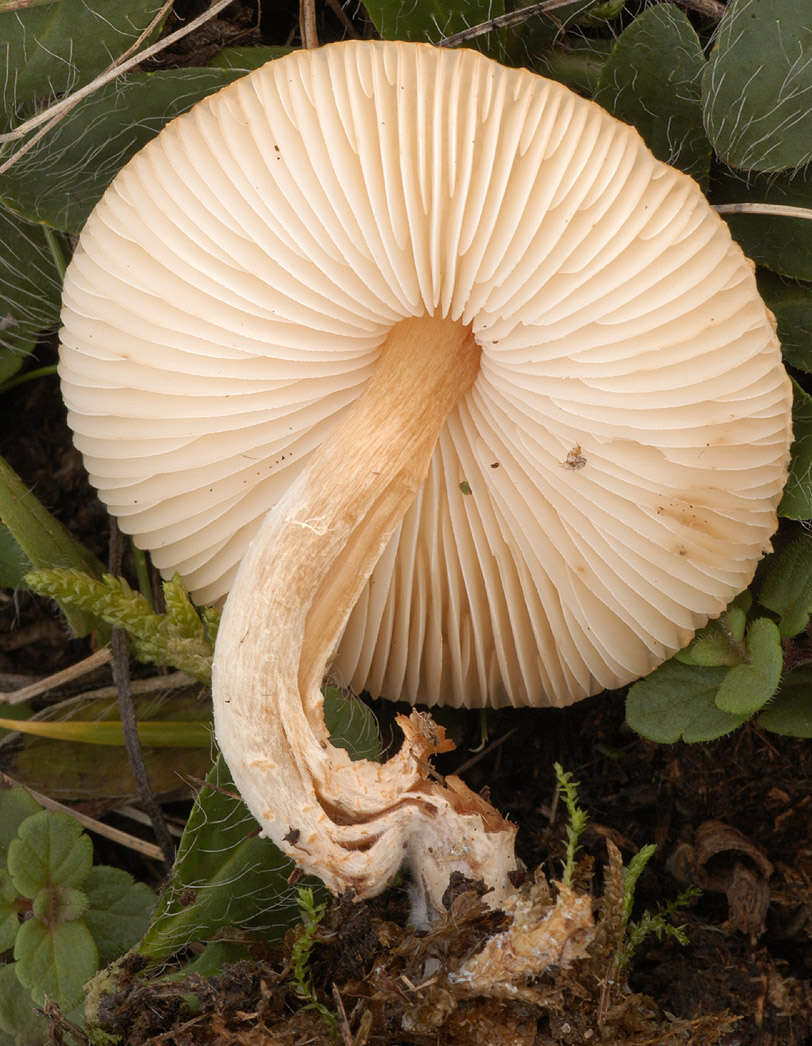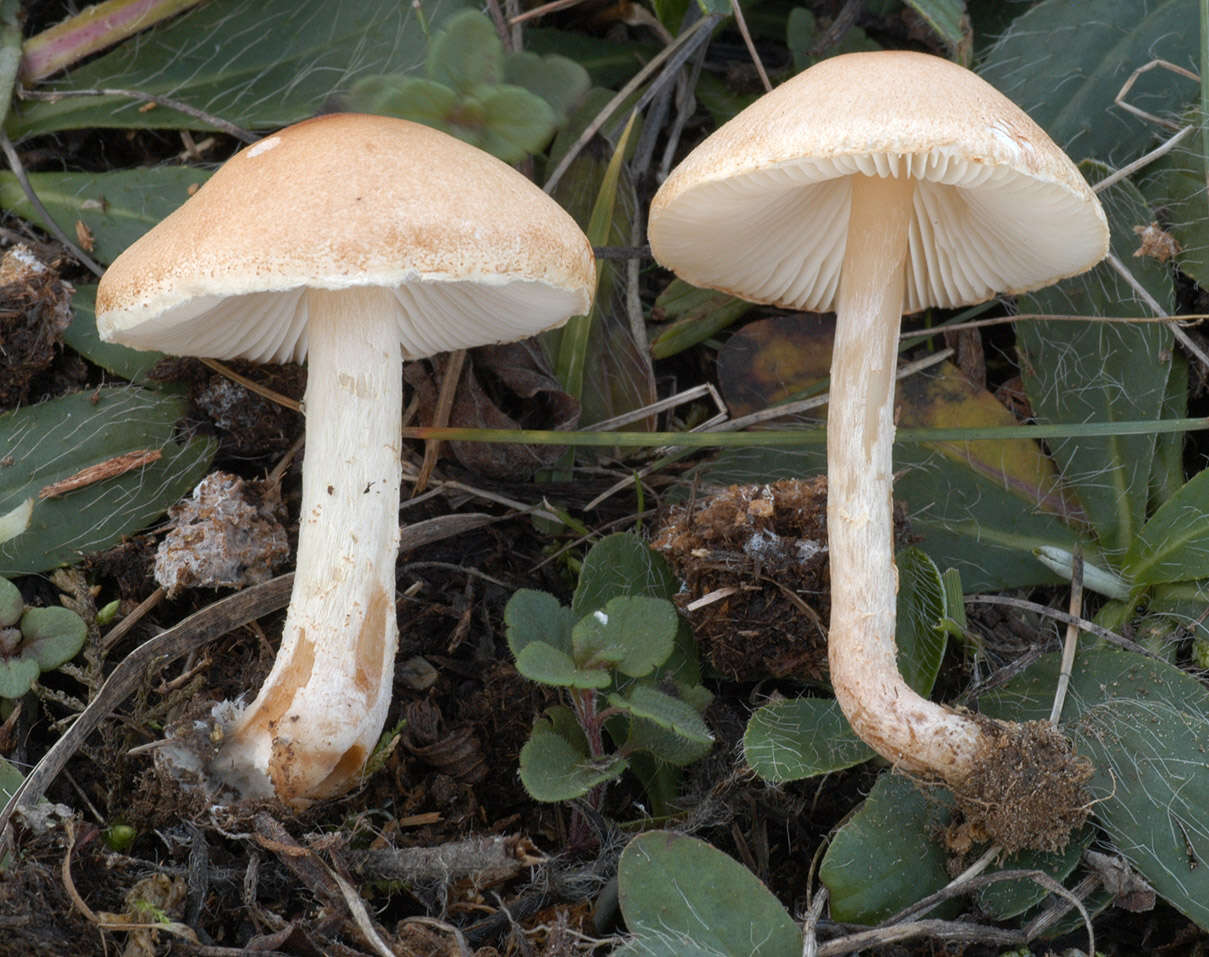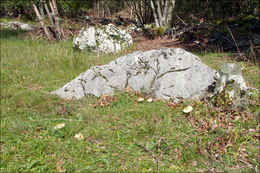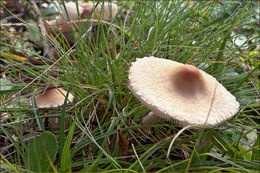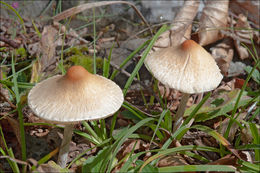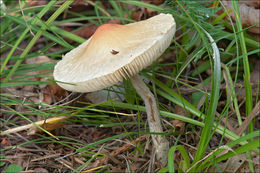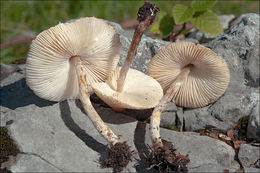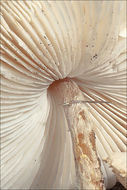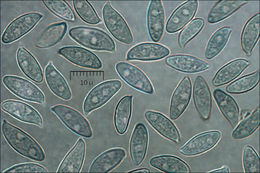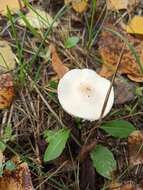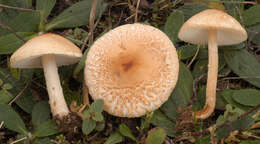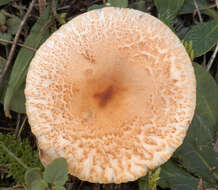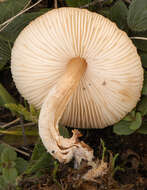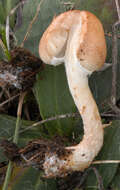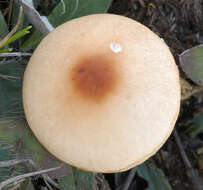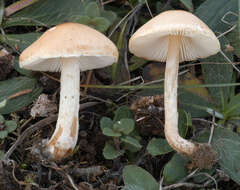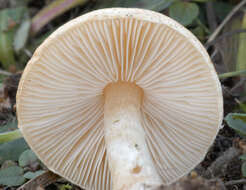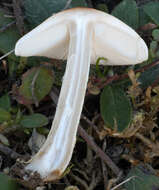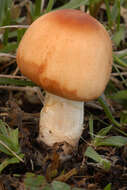-
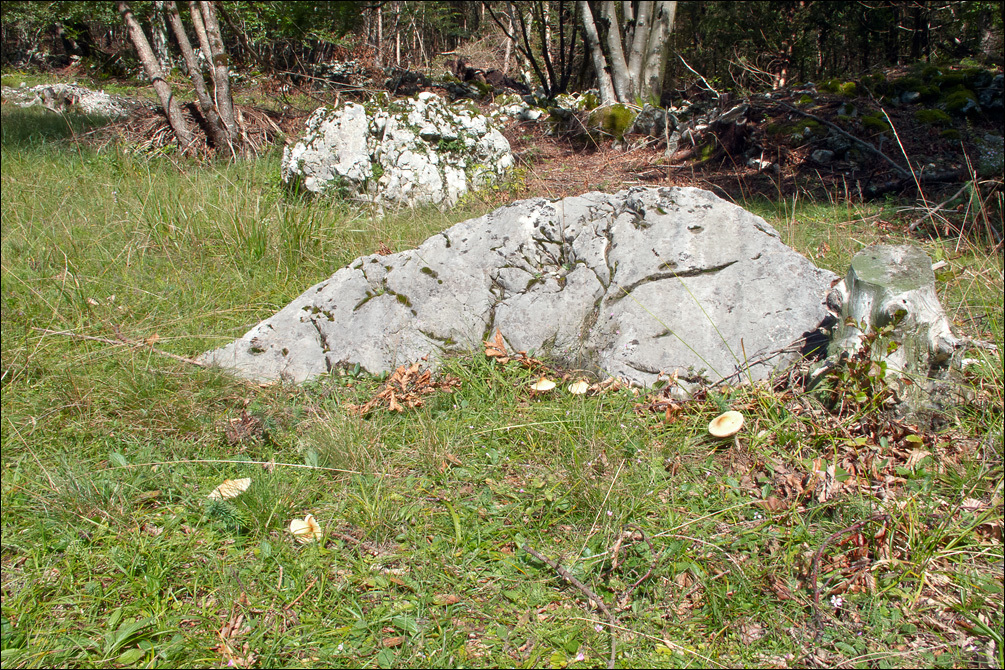
Slo.: gladki deniek - syn.: Lepiota pratensis (Buill.: Fr.) Rea, Lepiota laevigata (Lange) Lange - Habitat: grassland, mountain pasture; near mixed wood edge; moderately inclined mountain slope; southeast aspect; shallow soil, skeletal, calcareous ground; open, sunny place; dry and relatively warm place; exposed to direct rain; average precipitations ~ 3.000 mm/year, average temperature 7-9 deg C, elevation 620 m (2.050 feet), alpine phytogeographical region.Substratum: soil among grass.Comments: I find Lepiota a difficult genus regarding determination of species. For this find I was split between two options Lepiota clypeolaria and Lepiota oreadiformis. Lepiota clypeolaria is a much more frequent species in my country. Contrary, Lepiota oreadiformis is rare. Statistically the first option seems therefore much more probable. However, the sporocarps found were significantly smaller than of typical Lepiota clypeolaria, mature specimens lacked distinct annulus, and habitat of this find doesn't seem compatible with Lepiota clypeolaria at all (it grows in woods). Therefore it seems that Lepiota oreadiformis is a better fit. Typical habitat of this species are open places on dry, extensively used, not fertilized, base rich grassland, which perfectly fits to this find. With respect to pilei surface quite large differences can be found on pictures in the literature. Frequently pictures show pilei with smoother surface. However, authors state: pilei covered by 'distant, granular squamules, radially wrinkled' (Ref.:1), 'lightly covered by small, ocher brown, radially fibrous squamules' (Ref.4) and 'minutely felty when young, but breaking up into scales on ageing' (Ref.:2). Also, most pictures show pilei with less prominent buckle. So, I am not completely sure the determination is correct. Unfortunately, spore dimensions proved to be of no use for determination, at least against Lepiota clypeolaria. Differences in average spore dimensions for a given species among authors are larger than average differences between both species.Growing scattered and in small groups; about ten pilei present; pilei diameter 3 - 4 (5) cm, stipe 4 - 6 cm long and 4 - 5 mm in diameter; on young pilei a faint, white, fibrous 'ring' noticeable, mature fruitbodies with no observable ring; taste mild, not unpleasant; smell very mild but specific, on flour or cakes (?); SP faint, whitish-beige with slight green tint, oac6.Spores smooth. Dimensions: 10.9 [13 ; 13.8] 16 x 4.8 [5.4 ; 5.6] 6.2 microns; Q = 2.1 [2.4 ; 2.5] 2.8; N = 40; C = 95%; Me = 13.4 x 5.5 microns; Qe = 2.4. Olympus CH20, NEA 100x/1.25, magnification 1.000 x, oil, in water, in vivo. AmScope MA500 digital camera.Herbarium: Mycotheca and lichen herbarium (LJU-Li) of Slovenian Forestry Institute, Vena pot 2, Ljubljana, Index Herbariorum LJFRef.:(1) J. Breitenbach, F. Kraenzlin, Eds., Fungi of Switzerland, Vol.4., Verlag Mykologia (2000), p 204. (2) S. Buczacki, Collins Fungi Guide, Collins (2012), p 52. (3) R. Phillips, Mushrooms, Macmillan (2006), p 130. (4) G.J. Krieglsteiner (Hrsg.), Die Grosspilze Baden-Wrttembergs, Band 4., Ulmer (2003), p 91. (5) L. Hagar, Ottova Encyklopedia Hb, Ottova Nakladatelstvi, Praha (2015) (in Slovakian), p 904.
-
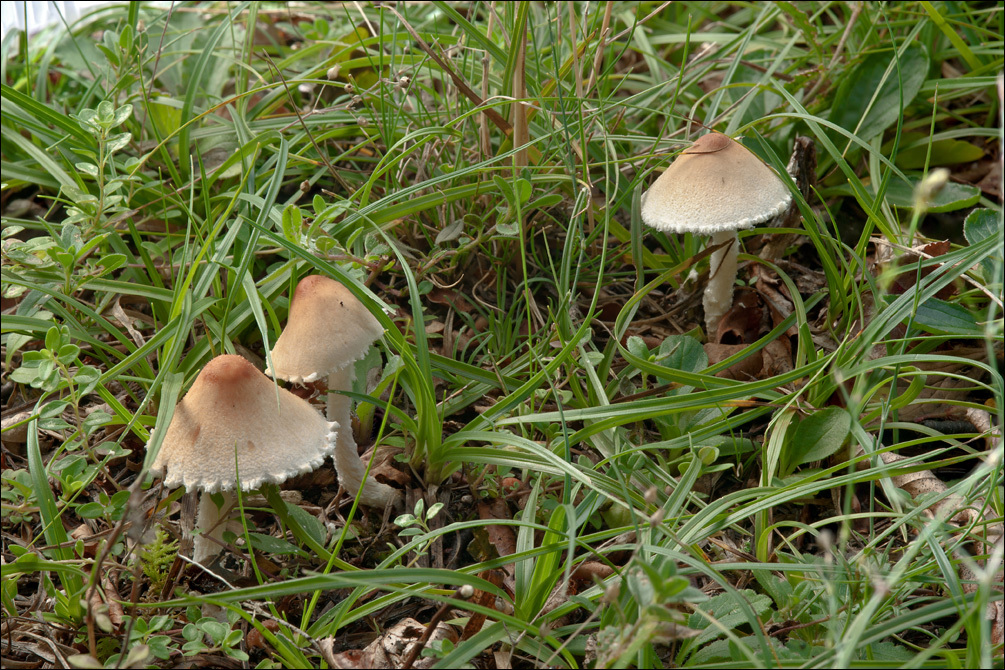
Slo.: gladki deniek - syn.: Lepiota pratensis (Buill.: Fr.) Rea, Lepiota laevigata (Lange) Lange - Habitat: grassland, mountain pasture; near mixed wood edge; moderately inclined mountain slope; southeast aspect; shallow soil, skeletal, calcareous ground; open, sunny place; dry and relatively warm place; exposed to direct rain; average precipitations ~ 3.000 mm/year, average temperature 7-9 deg C, elevation 620 m (2.050 feet), alpine phytogeographical region. Substratum: soil among grass. Comments: I find Lepiota a difficult genus regarding determination of species. For this find I was split between two options Lepiota clypeolaria and Lepiota oreadiformis. Lepiota clypeolaria is a much more frequent species in my country. Contrary, Lepiota oreadiformis is rare. Statistically the first option seems therefore much more probable. However, the sporocarps found were significantly smaller than of typical Lepiota clypeolaria, mature specimens lacked distinct annulus, and habitat of this find doesn't seem compatible with Lepiota clypeolaria at all (it grows in woods). Therefore it seems that Lepiota oreadiformis is a better fit. Typical habitat of this species are open places on dry, extensively used, not fertilized, base rich grassland, which perfectly fits to this find. With respect to pilei surface quite large differences can be found on pictures in the literature. Frequently pictures show pilei with smoother surface. However, authors state: pilei covered by 'distant, granular squamules, radially wrinkled' (Ref.:1), 'lightly covered by small, ocher brown, radially fibrous squamules' (Ref.4) and 'minutely felty when young, but breaking up into scales on ageing' (Ref.:2). Also, most pictures show pilei with less prominent buckle. So, I am not completely sure the determination is correct. Unfortunately, spore dimensions proved to be of no use for determination, at least against Lepiota clypeolaria. Differences in average spore dimensions for a given species among authors are larger than average differences between both species. Growing scattered and in small groups; about ten pilei present; pilei diameter 3 - 4 (5) cm, stipe 4 - 6 cm long and 4 - 5 mm in diameter; on young pilei a faint, white, fibrous 'ring' noticeable, mature fruitbodies with no observable ring; taste mild, not unpleasant; smell very mild but specific, on flour or cakes (?); SP faint, whitish-beige with slight green tint, oac6. Spores smooth. Dimensions: 10.9 [13 ; 13.8] 16 x 4.8 [5.4 ; 5.6] 6.2 microns; Q = 2.1 [2.4 ; 2.5] 2.8; N = 40; C = 95%; Me = 13.4 x 5.5 microns; Qe = 2.4. Olympus CH20, NEA 100x/1.25, magnification 1.000 x, oil, in water, in vivo. AmScope MA500 digital camera. Herbarium: Mycotheca and lichen herbarium (LJU-Li) of Slovenian Forestry Institute, Vena pot 2, Ljubljana, Index Herbariorum LJF Ref.: (1) J. Breitenbach, F. Kraenzlin, Eds., Fungi of Switzerland, Vol.4., Verlag Mykologia (2000), p 204. (2) S. Buczacki, Collins Fungi Guide, Collins (2012), p 52. (3) R. Phillips, Mushrooms, Macmillan (2006), p 130. (4) G.J. Krieglsteiner (Hrsg.), Die Grosspilze Baden-Wrttembergs, Band 4., Ulmer (2003), p 91. (5) L. Hagar, Ottova Encyklopedia Hb, Ottova Nakladatelstvi, Praha (2015) (in Slovakian), p 904.
-
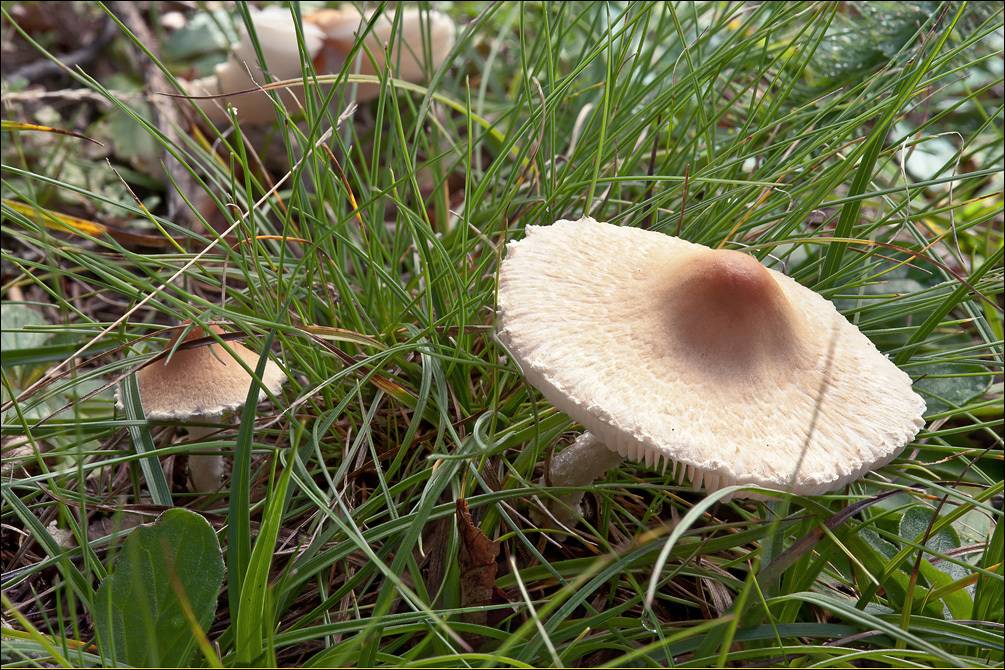
Slo.: gladki deniek - syn.: Lepiota pratensis (Buill.: Fr.) Rea, Lepiota laevigata (Lange) Lange - Habitat: grassland, mountain pasture; near mixed wood edge; moderately inclined mountain slope; southeast aspect; shallow soil, skeletal, calcareous ground; open, sunny place; dry and relatively warm place; exposed to direct rain; average precipitations ~ 3.000 mm/year, average temperature 7-9 deg C, elevation 620 m (2.050 feet), alpine phytogeographical region. Substratum: soil among grass. Comments: I find Lepiota a difficult genus regarding determination of species. For this find I was split between two options Lepiota clypeolaria and Lepiota oreadiformis. Lepiota clypeolaria is a much more frequent species in my country. Contrary, Lepiota oreadiformis is rare. Statistically the first option seems therefore much more probable. However, the sporocarps found were significantly smaller than of typical Lepiota clypeolaria, mature specimens lacked distinct annulus, and habitat of this find doesn't seem compatible with Lepiota clypeolaria at all (it grows in woods). Therefore it seems that Lepiota oreadiformis is a better fit. Typical habitat of this species are open places on dry, extensively used, not fertilized, base rich grassland, which perfectly fits to this find. With respect to pilei surface quite large differences can be found on pictures in the literature. Frequently pictures show pilei with smoother surface. However, authors state: pilei covered by 'distant, granular squamules, radially wrinkled' (Ref.:1), 'lightly covered by small, ocher brown, radially fibrous squamules' (Ref.4) and 'minutely felty when young, but breaking up into scales on ageing' (Ref.:2). Also, most pictures show pilei with less prominent buckle. So, I am not completely sure the determination is correct. Unfortunately, spore dimensions proved to be of no use for determination, at least against Lepiota clypeolaria. Differences in average spore dimensions for a given species among authors are larger than average differences between both species. Growing scattered and in small groups; about ten pilei present; pilei diameter 3 - 4 (5) cm, stipe 4 - 6 cm long and 4 - 5 mm in diameter; on young pilei a faint, white, fibrous 'ring' noticeable, mature fruitbodies with no observable ring; taste mild, not unpleasant; smell very mild but specific, on flour or cakes (?); SP faint, whitish-beige with slight green tint, oac6. Spores smooth. Dimensions: 10.9 [13 ; 13.8] 16 x 4.8 [5.4 ; 5.6] 6.2 microns; Q = 2.1 [2.4 ; 2.5] 2.8; N = 40; C = 95%; Me = 13.4 x 5.5 microns; Qe = 2.4. Olympus CH20, NEA 100x/1.25, magnification 1.000 x, oil, in water, in vivo. AmScope MA500 digital camera. Herbarium: Mycotheca and lichen herbarium (LJU-Li) of Slovenian Forestry Institute, Vena pot 2, Ljubljana, Index Herbariorum LJF Ref.: (1) J. Breitenbach, F. Kraenzlin, Eds., Fungi of Switzerland, Vol.4., Verlag Mykologia (2000), p 204. (2) S. Buczacki, Collins Fungi Guide, Collins (2012), p 52. (3) R. Phillips, Mushrooms, Macmillan (2006), p 130. (4) G.J. Krieglsteiner (Hrsg.), Die Grosspilze Baden-Wrttembergs, Band 4., Ulmer (2003), p 91. (5) L. Hagar, Ottova Encyklopedia Hb, Ottova Nakladatelstvi, Praha (2015) (in Slovakian), p 904.
-

Slo.: gladki deniek - syn.: Lepiota pratensis (Buill.: Fr.) Rea, Lepiota laevigata (Lange) Lange - Habitat: grassland, mountain pasture; near mixed wood edge; moderately inclined mountain slope; southeast aspect; shallow soil, skeletal, calcareous ground; open, sunny place; dry and relatively warm place; exposed to direct rain; average precipitations ~ 3.000 mm/year, average temperature 7-9 deg C, elevation 620 m (2.050 feet), alpine phytogeographical region. Substratum: soil among grass. Comments: I find Lepiota a difficult genus regarding determination of species. For this find I was split between two options Lepiota clypeolaria and Lepiota oreadiformis. Lepiota clypeolaria is a much more frequent species in my country. Contrary, Lepiota oreadiformis is rare. Statistically the first option seems therefore much more probable. However, the sporocarps found were significantly smaller than of typical Lepiota clypeolaria, mature specimens lacked distinct annulus, and habitat of this find doesn't seem compatible with Lepiota clypeolaria at all (it grows in woods). Therefore it seems that Lepiota oreadiformis is a better fit. Typical habitat of this species are open places on dry, extensively used, not fertilized, base rich grassland, which perfectly fits to this find. With respect to pilei surface quite large differences can be found on pictures in the literature. Frequently pictures show pilei with smoother surface. However, authors state: pilei covered by 'distant, granular squamules, radially wrinkled' (Ref.:1), 'lightly covered by small, ocher brown, radially fibrous squamules' (Ref.4) and 'minutely felty when young, but breaking up into scales on ageing' (Ref.:2). Also, most pictures show pilei with less prominent buckle. So, I am not completely sure the determination is correct. Unfortunately, spore dimensions proved to be of no use for determination, at least against Lepiota clypeolaria. Differences in average spore dimensions for a given species among authors are larger than average differences between both species. Growing scattered and in small groups; about ten pilei present; pilei diameter 3 - 4 (5) cm, stipe 4 - 6 cm long and 4 - 5 mm in diameter; on young pilei a faint, white, fibrous 'ring' noticeable, mature fruitbodies with no observable ring; taste mild, not unpleasant; smell very mild but specific, on flour or cakes (?); SP faint, whitish-beige with slight green tint, oac6. Spores smooth. Dimensions: 10.9 [13 ; 13.8] 16 x 4.8 [5.4 ; 5.6] 6.2 microns; Q = 2.1 [2.4 ; 2.5] 2.8; N = 40; C = 95%; Me = 13.4 x 5.5 microns; Qe = 2.4. Olympus CH20, NEA 100x/1.25, magnification 1.000 x, oil, in water, in vivo. AmScope MA500 digital camera. Herbarium: Mycotheca and lichen herbarium (LJU-Li) of Slovenian Forestry Institute, Vena pot 2, Ljubljana, Index Herbariorum LJF Ref.: (1) J. Breitenbach, F. Kraenzlin, Eds., Fungi of Switzerland, Vol.4., Verlag Mykologia (2000), p 204. (2) S. Buczacki, Collins Fungi Guide, Collins (2012), p 52. (3) R. Phillips, Mushrooms, Macmillan (2006), p 130. (4) G.J. Krieglsteiner (Hrsg.), Die Grosspilze Baden-Wrttembergs, Band 4., Ulmer (2003), p 91. (5) L. Hagar, Ottova Encyklopedia Hb, Ottova Nakladatelstvi, Praha (2015) (in Slovakian), p 904.
-

Slo.: gladki deniek - syn.: Lepiota pratensis (Buill.: Fr.) Rea, Lepiota laevigata (Lange) Lange - Habitat: grassland, mountain pasture; near mixed wood edge; moderately inclined mountain slope; southeast aspect; shallow soil, skeletal, calcareous ground; open, sunny place; dry and relatively warm place; exposed to direct rain; average precipitations ~ 3.000 mm/year, average temperature 7-9 deg C, elevation 620 m (2.050 feet), alpine phytogeographical region. Substratum: soil among grass. Comments: I find Lepiota a difficult genus regarding determination of species. For this find I was split between two options Lepiota clypeolaria and Lepiota oreadiformis. Lepiota clypeolaria is a much more frequent species in my country. Contrary, Lepiota oreadiformis is rare. Statistically the first option seems therefore much more probable. However, the sporocarps found were significantly smaller than of typical Lepiota clypeolaria, mature specimens lacked distinct annulus, and habitat of this find doesn't seem compatible with Lepiota clypeolaria at all (it grows in woods). Therefore it seems that Lepiota oreadiformis is a better fit. Typical habitat of this species are open places on dry, extensively used, not fertilized, base rich grassland, which perfectly fits to this find. With respect to pilei surface quite large differences can be found on pictures in the literature. Frequently pictures show pilei with smoother surface. However, authors state: pilei covered by 'distant, granular squamules, radially wrinkled' (Ref.:1), 'lightly covered by small, ocher brown, radially fibrous squamules' (Ref.4) and 'minutely felty when young, but breaking up into scales on ageing' (Ref.:2). Also, most pictures show pilei with less prominent buckle. So, I am not completely sure the determination is correct. Unfortunately, spore dimensions proved to be of no use for determination, at least against Lepiota clypeolaria. Differences in average spore dimensions for a given species among authors are larger than average differences between both species. Growing scattered and in small groups; about ten pilei present; pilei diameter 3 - 4 (5) cm, stipe 4 - 6 cm long and 4 - 5 mm in diameter; on young pilei a faint, white, fibrous 'ring' noticeable, mature fruitbodies with no observable ring; taste mild, not unpleasant; smell very mild but specific, on flour or cakes (?); SP faint, whitish-beige with slight green tint, oac6. Spores smooth. Dimensions: 10.9 [13 ; 13.8] 16 x 4.8 [5.4 ; 5.6] 6.2 microns; Q = 2.1 [2.4 ; 2.5] 2.8; N = 40; C = 95%; Me = 13.4 x 5.5 microns; Qe = 2.4. Olympus CH20, NEA 100x/1.25, magnification 1.000 x, oil, in water, in vivo. AmScope MA500 digital camera. Herbarium: Mycotheca and lichen herbarium (LJU-Li) of Slovenian Forestry Institute, Vena pot 2, Ljubljana, Index Herbariorum LJF Ref.: (1) J. Breitenbach, F. Kraenzlin, Eds., Fungi of Switzerland, Vol.4., Verlag Mykologia (2000), p 204. (2) S. Buczacki, Collins Fungi Guide, Collins (2012), p 52. (3) R. Phillips, Mushrooms, Macmillan (2006), p 130. (4) G.J. Krieglsteiner (Hrsg.), Die Grosspilze Baden-Wrttembergs, Band 4., Ulmer (2003), p 91. (5) L. Hagar, Ottova Encyklopedia Hb, Ottova Nakladatelstvi, Praha (2015) (in Slovakian), p 904.
-
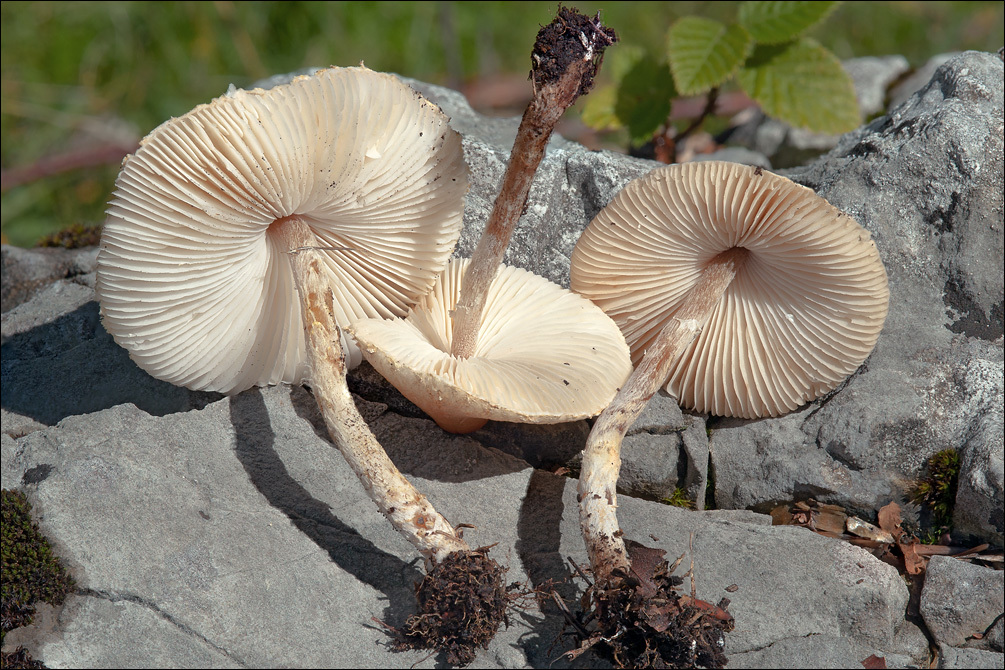
Slo.: gladki deniek - syn.: Lepiota pratensis (Buill.: Fr.) Rea, Lepiota laevigata (Lange) Lange - Habitat: grassland, mountain pasture; near mixed wood edge; moderately inclined mountain slope; southeast aspect; shallow soil, skeletal, calcareous ground; open, sunny place; dry and relatively warm place; exposed to direct rain; average precipitations ~ 3.000 mm/year, average temperature 7-9 deg C, elevation 620 m (2.050 feet), alpine phytogeographical region. Substratum: soil among grass. Comments: I find Lepiota a difficult genus regarding determination of species. For this find I was split between two options Lepiota clypeolaria and Lepiota oreadiformis. Lepiota clypeolaria is a much more frequent species in my country. Contrary, Lepiota oreadiformis is rare. Statistically the first option seems therefore much more probable. However, the sporocarps found were significantly smaller than of typical Lepiota clypeolaria, mature specimens lacked distinct annulus, and habitat of this find doesn't seem compatible with Lepiota clypeolaria at all (it grows in woods). Therefore it seems that Lepiota oreadiformis is a better fit. Typical habitat of this species are open places on dry, extensively used, not fertilized, base rich grassland, which perfectly fits to this find. With respect to pilei surface quite large differences can be found on pictures in the literature. Frequently pictures show pilei with smoother surface. However, authors state: pilei covered by 'distant, granular squamules, radially wrinkled' (Ref.:1), 'lightly covered by small, ocher brown, radially fibrous squamules' (Ref.4) and 'minutely felty when young, but breaking up into scales on ageing' (Ref.:2). Also, most pictures show pilei with less prominent buckle. So, I am not completely sure the determination is correct. Unfortunately, spore dimensions proved to be of no use for determination, at least against Lepiota clypeolaria. Differences in average spore dimensions for a given species among authors are larger than average differences between both species. Growing scattered and in small groups; about ten pilei present; pilei diameter 3 - 4 (5) cm, stipe 4 - 6 cm long and 4 - 5 mm in diameter; on young pilei a faint, white, fibrous 'ring' noticeable, mature fruitbodies with no observable ring; taste mild, not unpleasant; smell very mild but specific, on flour or cakes (?); SP faint, whitish-beige with slight green tint, oac6. Spores smooth. Dimensions: 10.9 [13 ; 13.8] 16 x 4.8 [5.4 ; 5.6] 6.2 microns; Q = 2.1 [2.4 ; 2.5] 2.8; N = 40; C = 95%; Me = 13.4 x 5.5 microns; Qe = 2.4. Olympus CH20, NEA 100x/1.25, magnification 1.000 x, oil, in water, in vivo. AmScope MA500 digital camera. Herbarium: Mycotheca and lichen herbarium (LJU-Li) of Slovenian Forestry Institute, Vena pot 2, Ljubljana, Index Herbariorum LJF Ref.: (1) J. Breitenbach, F. Kraenzlin, Eds., Fungi of Switzerland, Vol.4., Verlag Mykologia (2000), p 204. (2) S. Buczacki, Collins Fungi Guide, Collins (2012), p 52. (3) R. Phillips, Mushrooms, Macmillan (2006), p 130. (4) G.J. Krieglsteiner (Hrsg.), Die Grosspilze Baden-Wrttembergs, Band 4., Ulmer (2003), p 91. (5) L. Hagar, Ottova Encyklopedia Hb, Ottova Nakladatelstvi, Praha (2015) (in Slovakian), p 904.
-
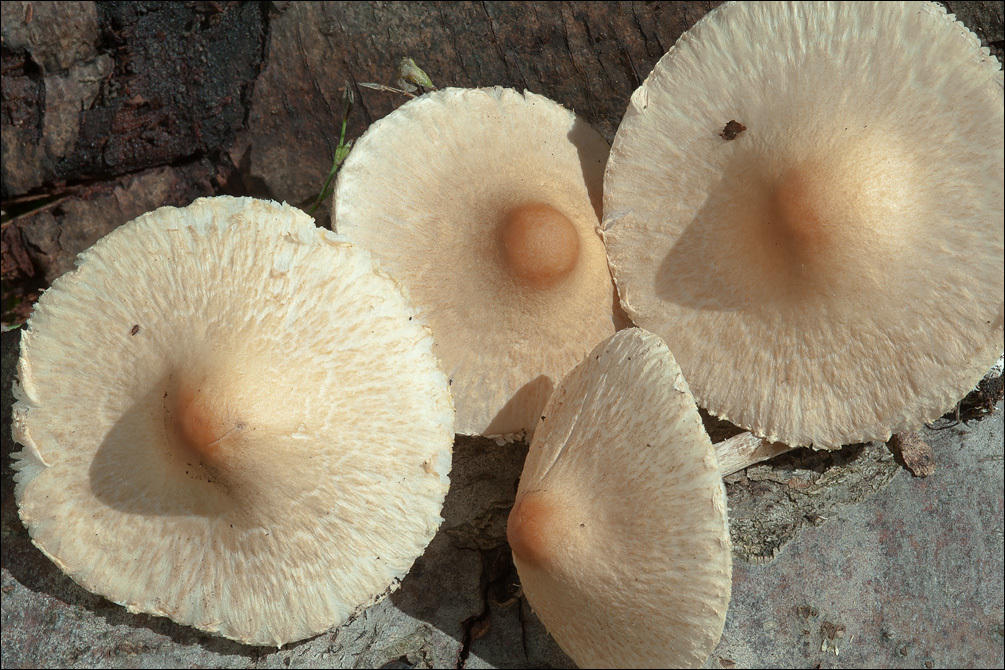
Slo.: gladki deniek - syn.: Lepiota pratensis (Buill.: Fr.) Rea, Lepiota laevigata (Lange) Lange - Habitat: grassland, mountain pasture; near mixed wood edge; moderately inclined mountain slope; southeast aspect; shallow soil, skeletal, calcareous ground; open, sunny place; dry and relatively warm place; exposed to direct rain; average precipitations ~ 3.000 mm/year, average temperature 7-9 deg C, elevation 620 m (2.050 feet), alpine phytogeographical region. Substratum: soil among grass. Comments: I find Lepiota a difficult genus regarding determination of species. For this find I was split between two options Lepiota clypeolaria and Lepiota oreadiformis. Lepiota clypeolaria is a much more frequent species in my country. Contrary, Lepiota oreadiformis is rare. Statistically the first option seems therefore much more probable. However, the sporocarps found were significantly smaller than of typical Lepiota clypeolaria, mature specimens lacked distinct annulus, and habitat of this find doesn't seem compatible with Lepiota clypeolaria at all (it grows in woods). Therefore it seems that Lepiota oreadiformis is a better fit. Typical habitat of this species are open places on dry, extensively used, not fertilized, base rich grassland, which perfectly fits to this find. With respect to pilei surface quite large differences can be found on pictures in the literature. Frequently pictures show pilei with smoother surface. However, authors state: pilei covered by 'distant, granular squamules, radially wrinkled' (Ref.:1), 'lightly covered by small, ocher brown, radially fibrous squamules' (Ref.4) and 'minutely felty when young, but breaking up into scales on ageing' (Ref.:2). Also, most pictures show pilei with less prominent buckle. So, I am not completely sure the determination is correct. Unfortunately, spore dimensions proved to be of no use for determination, at least against Lepiota clypeolaria. Differences in average spore dimensions for a given species among authors are larger than average differences between both species. Growing scattered and in small groups; about ten pilei present; pilei diameter 3 - 4 (5) cm, stipe 4 - 6 cm long and 4 - 5 mm in diameter; on young pilei a faint, white, fibrous 'ring' noticeable, mature fruitbodies with no observable ring; taste mild, not unpleasant; smell very mild but specific, on flour or cakes (?); SP faint, whitish-beige with slight green tint, oac6. Spores smooth. Dimensions: 10.9 [13 ; 13.8] 16 x 4.8 [5.4 ; 5.6] 6.2 microns; Q = 2.1 [2.4 ; 2.5] 2.8; N = 40; C = 95%; Me = 13.4 x 5.5 microns; Qe = 2.4. Olympus CH20, NEA 100x/1.25, magnification 1.000 x, oil, in water, in vivo. AmScope MA500 digital camera. Herbarium: Mycotheca and lichen herbarium (LJU-Li) of Slovenian Forestry Institute, Vena pot 2, Ljubljana, Index Herbariorum LJF Ref.: (1) J. Breitenbach, F. Kraenzlin, Eds., Fungi of Switzerland, Vol.4., Verlag Mykologia (2000), p 204. (2) S. Buczacki, Collins Fungi Guide, Collins (2012), p 52. (3) R. Phillips, Mushrooms, Macmillan (2006), p 130. (4) G.J. Krieglsteiner (Hrsg.), Die Grosspilze Baden-Wrttembergs, Band 4., Ulmer (2003), p 91. (5) L. Hagar, Ottova Encyklopedia Hb, Ottova Nakladatelstvi, Praha (2015) (in Slovakian), p 904.
-
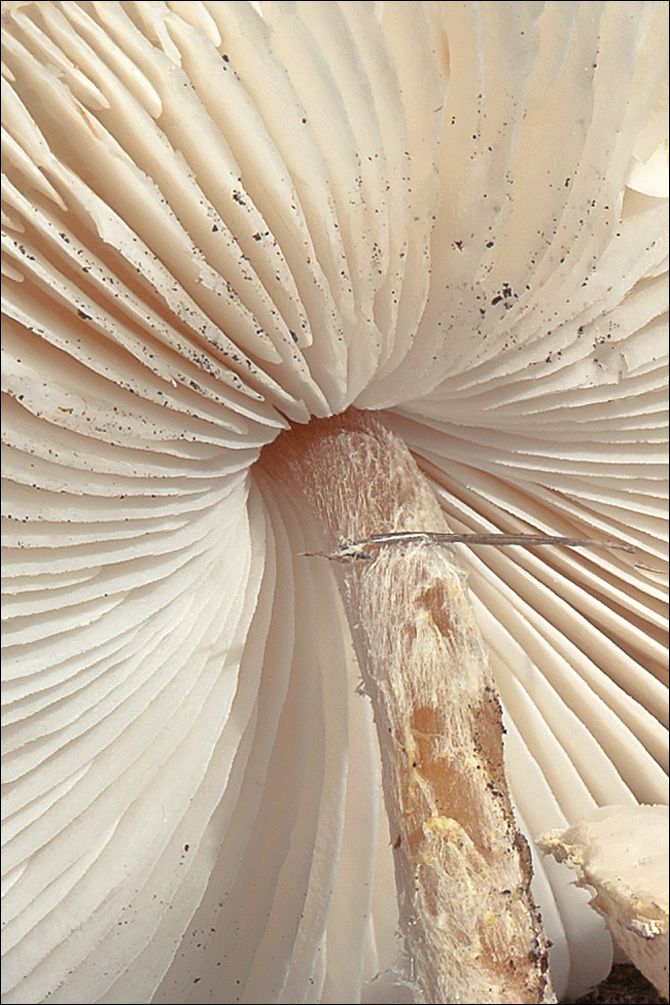
Slo.: gladki deniek - syn.: Lepiota pratensis (Buill.: Fr.) Rea, Lepiota laevigata (Lange) Lange - Habitat: grassland, mountain pasture; near mixed wood edge; moderately inclined mountain slope; southeast aspect; shallow soil, skeletal, calcareous ground; open, sunny place; dry and relatively warm place; exposed to direct rain; average precipitations ~ 3.000 mm/year, average temperature 7-9 deg C, elevation 620 m (2.050 feet), alpine phytogeographical region. Substratum: soil among grass. Comments: I find Lepiota a difficult genus regarding determination of species. For this find I was split between two options Lepiota clypeolaria and Lepiota oreadiformis. Lepiota clypeolaria is a much more frequent species in my country. Contrary, Lepiota oreadiformis is rare. Statistically the first option seems therefore much more probable. However, the sporocarps found were significantly smaller than of typical Lepiota clypeolaria, mature specimens lacked distinct annulus, and habitat of this find doesn't seem compatible with Lepiota clypeolaria at all (it grows in woods). Therefore it seems that Lepiota oreadiformis is a better fit. Typical habitat of this species are open places on dry, extensively used, not fertilized, base rich grassland, which perfectly fits to this find. With respect to pilei surface quite large differences can be found on pictures in the literature. Frequently pictures show pilei with smoother surface. However, authors state: pilei covered by 'distant, granular squamules, radially wrinkled' (Ref.:1), 'lightly covered by small, ocher brown, radially fibrous squamules' (Ref.4) and 'minutely felty when young, but breaking up into scales on ageing' (Ref.:2). Also, most pictures show pilei with less prominent buckle. So, I am not completely sure the determination is correct. Unfortunately, spore dimensions proved to be of no use for determination, at least against Lepiota clypeolaria. Differences in average spore dimensions for a given species among authors are larger than average differences between both species. Growing scattered and in small groups; about ten pilei present; pilei diameter 3 - 4 (5) cm, stipe 4 - 6 cm long and 4 - 5 mm in diameter; on young pilei a faint, white, fibrous 'ring' noticeable, mature fruitbodies with no observable ring; taste mild, not unpleasant; smell very mild but specific, on flour or cakes (?); SP faint, whitish-beige with slight green tint, oac6. Spores smooth. Dimensions: 10.9 [13 ; 13.8] 16 x 4.8 [5.4 ; 5.6] 6.2 microns; Q = 2.1 [2.4 ; 2.5] 2.8; N = 40; C = 95%; Me = 13.4 x 5.5 microns; Qe = 2.4. Olympus CH20, NEA 100x/1.25, magnification 1.000 x, oil, in water, in vivo. AmScope MA500 digital camera. Herbarium: Mycotheca and lichen herbarium (LJU-Li) of Slovenian Forestry Institute, Vena pot 2, Ljubljana, Index Herbariorum LJF Ref.: (1) J. Breitenbach, F. Kraenzlin, Eds., Fungi of Switzerland, Vol.4., Verlag Mykologia (2000), p 204. (2) S. Buczacki, Collins Fungi Guide, Collins (2012), p 52. (3) R. Phillips, Mushrooms, Macmillan (2006), p 130. (4) G.J. Krieglsteiner (Hrsg.), Die Grosspilze Baden-Wrttembergs, Band 4., Ulmer (2003), p 91. (5) L. Hagar, Ottova Encyklopedia Hb, Ottova Nakladatelstvi, Praha (2015) (in Slovakian), p 904.
-

Slo.: gladki deniek - syn.: Lepiota pratensis (Buill.: Fr.) Rea, Lepiota laevigata (Lange) Lange - Habitat: grassland, mountain pasture; near mixed wood edge; moderately inclined mountain slope; southeast aspect; shallow soil, skeletal, calcareous ground; open, sunny place; dry and relatively warm place; exposed to direct rain; average precipitations ~ 3.000 mm/year, average temperature 7-9 deg C, elevation 620 m (2.050 feet), alpine phytogeographical region. Substratum: soil among grass. Comments: I find Lepiota a difficult genus regarding determination of species. For this find I was split between two options Lepiota clypeolaria and Lepiota oreadiformis. Lepiota clypeolaria is a much more frequent species in my country. Contrary, Lepiota oreadiformis is rare. Statistically the first option seems therefore much more probable. However, the sporocarps found were significantly smaller than of typical Lepiota clypeolaria, mature specimens lacked distinct annulus, and habitat of this find doesn't seem compatible with Lepiota clypeolaria at all (it grows in woods). Therefore it seems that Lepiota oreadiformis is a better fit. Typical habitat of this species are open places on dry, extensively used, not fertilized, base rich grassland, which perfectly fits to this find. With respect to pilei surface quite large differences can be found on pictures in the literature. Frequently pictures show pilei with smoother surface. However, authors state: pilei covered by 'distant, granular squamules, radially wrinkled' (Ref.:1), 'lightly covered by small, ocher brown, radially fibrous squamules' (Ref.4) and 'minutely felty when young, but breaking up into scales on ageing' (Ref.:2). Also, most pictures show pilei with less prominent buckle. So, I am not completely sure the determination is correct. Unfortunately, spore dimensions proved to be of no use for determination, at least against Lepiota clypeolaria. Differences in average spore dimensions for a given species among authors are larger than average differences between both species. Growing scattered and in small groups; about ten pilei present; pilei diameter 3 - 4 (5) cm, stipe 4 - 6 cm long and 4 - 5 mm in diameter; on young pilei a faint, white, fibrous 'ring' noticeable, mature fruitbodies with no observable ring; taste mild, not unpleasant; smell very mild but specific, on flour or cakes (?); SP faint, whitish-beige with slight green tint, oac6. Spores smooth. Dimensions: 10.9 [13 ; 13.8] 16 x 4.8 [5.4 ; 5.6] 6.2 microns; Q = 2.1 [2.4 ; 2.5] 2.8; N = 40; C = 95%; Me = 13.4 x 5.5 microns; Qe = 2.4. Olympus CH20, NEA 100x/1.25, magnification 1.000 x, oil, in water, in vivo. AmScope MA500 digital camera. Herbarium: Mycotheca and lichen herbarium (LJU-Li) of Slovenian Forestry Institute, Vena pot 2, Ljubljana, Index Herbariorum LJF Ref.: (1) J. Breitenbach, F. Kraenzlin, Eds., Fungi of Switzerland, Vol.4., Verlag Mykologia (2000), p 204. (2) S. Buczacki, Collins Fungi Guide, Collins (2012), p 52. (3) R. Phillips, Mushrooms, Macmillan (2006), p 130. (4) G.J. Krieglsteiner (Hrsg.), Die Grosspilze Baden-Wrttembergs, Band 4., Ulmer (2003), p 91. (5) L. Hagar, Ottova Encyklopedia Hb, Ottova Nakladatelstvi, Praha (2015) (in Slovakian), p 904.
-
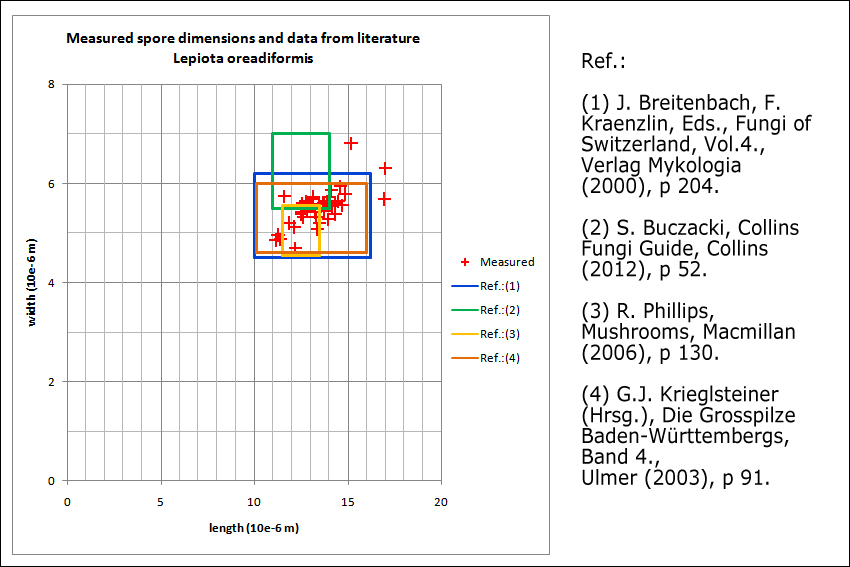
Slo.: gladki deniek - syn.: Lepiota pratensis (Buill.: Fr.) Rea, Lepiota laevigata (Lange) Lange - Habitat: grassland, mountain pasture; near mixed wood edge; moderately inclined mountain slope; southeast aspect; shallow soil, skeletal, calcareous ground; open, sunny place; dry and relatively warm place; exposed to direct rain; average precipitations ~ 3.000 mm/year, average temperature 7-9 deg C, elevation 620 m (2.050 feet), alpine phytogeographical region. Substratum: soil among grass. Comments: I find Lepiota a difficult genus regarding determination of species. For this find I was split between two options Lepiota clypeolaria and Lepiota oreadiformis. Lepiota clypeolaria is a much more frequent species in my country. Contrary, Lepiota oreadiformis is rare. Statistically the first option seems therefore much more probable. However, the sporocarps found were significantly smaller than of typical Lepiota clypeolaria, mature specimens lacked distinct annulus, and habitat of this find doesn't seem compatible with Lepiota clypeolaria at all (it grows in woods). Therefore it seems that Lepiota oreadiformis is a better fit. Typical habitat of this species are open places on dry, extensively used, not fertilized, base rich grassland, which perfectly fits to this find. With respect to pilei surface quite large differences can be found on pictures in the literature. Frequently pictures show pilei with smoother surface. However, authors state: pilei covered by 'distant, granular squamules, radially wrinkled' (Ref.:1), 'lightly covered by small, ocher brown, radially fibrous squamules' (Ref.4) and 'minutely felty when young, but breaking up into scales on ageing' (Ref.:2). Also, most pictures show pilei with less prominent buckle. So, I am not completely sure the determination is correct. Unfortunately, spore dimensions proved to be of no use for determination, at least against Lepiota clypeolaria. Differences in average spore dimensions for a given species among authors are larger than average differences between both species. Growing scattered and in small groups; about ten pilei present; pilei diameter 3 - 4 (5) cm, stipe 4 - 6 cm long and 4 - 5 mm in diameter; on young pilei a faint, white, fibrous 'ring' noticeable, mature fruitbodies with no observable ring; taste mild, not unpleasant; smell very mild but specific, on flour or cakes (?); SP faint, whitish-beige with slight green tint, oac6. Spores smooth. Dimensions: 10.9 [13 ; 13.8] 16 x 4.8 [5.4 ; 5.6] 6.2 microns; Q = 2.1 [2.4 ; 2.5] 2.8; N = 40; C = 95%; Me = 13.4 x 5.5 microns; Qe = 2.4. Olympus CH20, NEA 100x/1.25, magnification 1.000 x, oil, in water, in vivo. AmScope MA500 digital camera. Herbarium: Mycotheca and lichen herbarium (LJU-Li) of Slovenian Forestry Institute, Vena pot 2, Ljubljana, Index Herbariorum LJF Ref.: (1) J. Breitenbach, F. Kraenzlin, Eds., Fungi of Switzerland, Vol.4., Verlag Mykologia (2000), p 204. (2) S. Buczacki, Collins Fungi Guide, Collins (2012), p 52. (3) R. Phillips, Mushrooms, Macmillan (2006), p 130. (4) G.J. Krieglsteiner (Hrsg.), Die Grosspilze Baden-Wrttembergs, Band 4., Ulmer (2003), p 91. (5) L. Hagar, Ottova Encyklopedia Hb, Ottova Nakladatelstvi, Praha (2015) (in Slovakian), p 904.
-
-
-
-
-
Longitude (deg): -1.2. Latitude (deg): 51.3. Longitude (deg/min): 1° 20' W. Latitude (deg/min): 51° 20' N. Vice county name: Berks. Vice county no.: 22. Country: England. Stage: Fruitbody. Identified by: Malcolm Storey. Photo summary: "toadstools, in situ, close-ups, LS, cap cuticle, cheilocystidia, spores". Comment: "6 fruitbodies, scattered over 10m, in species-rich grassland". Category: standard photograph or close-up. Photographic equipment used: Nikon D100 dSLR with Tamron SP T90 AF Macro 1:1 lens.
-
Longitude (deg): -1.2. Latitude (deg): 51.3. Longitude (deg/min): 1° 20' W. Latitude (deg/min): 51° 20' N. Vice county name: Berks. Vice county no.: 22. Country: England. Stage: Fruitbody. Identified by: Malcolm Storey. Photo summary: "toadstools, in situ, close-ups, LS, cap cuticle, cheilocystidia, spores". Comment: "6 fruitbodies, scattered over 10m, in species-rich grassland". Category: standard photograph or close-up. Photographic equipment used: Nikon D100 dSLR with Tamron SP T90 AF Macro 1:1 lens.
-
Longitude (deg): -1.2. Latitude (deg): 51.3. Longitude (deg/min): 1° 20' W. Latitude (deg/min): 51° 20' N. Vice county name: Berks. Vice county no.: 22. Country: England. Stage: Fruitbody. Identified by: Malcolm Storey. Photo summary: "toadstools, in situ, close-ups, LS, cap cuticle, cheilocystidia, spores". Comment: "6 fruitbodies, scattered over 10m, in species-rich grassland". Category: standard photograph or close-up. Photographic equipment used: Nikon D100 dSLR with Tamron SP T90 AF Macro 1:1 lens.
-
Longitude (deg): -1.2. Latitude (deg): 51.3. Longitude (deg/min): 1° 20' W. Latitude (deg/min): 51° 20' N. Vice county name: Berks. Vice county no.: 22. Country: England. Stage: Fruitbody. Identified by: Malcolm Storey. Photo summary: "toadstools, in situ, close-ups, LS, cap cuticle, cheilocystidia, spores". Comment: "6 fruitbodies, scattered over 10m, in species-rich grassland". Category: standard photograph or close-up. Photographic equipment used: Nikon D100 dSLR with Tamron SP T90 AF Macro 1:1 lens.
-
Longitude (deg): -1.2. Latitude (deg): 51.3. Longitude (deg/min): 1° 20' W. Latitude (deg/min): 51° 20' N. Vice county name: Berks. Vice county no.: 22. Country: England. Stage: Fruitbody. Identified by: Malcolm Storey. Photo summary: "toadstools, in situ, close-ups, LS, cap cuticle, cheilocystidia, spores". Comment: "6 fruitbodies, scattered over 10m, in species-rich grassland". Category: standard photograph or close-up. Photographic equipment used: Nikon D100 dSLR with Tamron SP T90 AF Macro 1:1 lens.
-
Longitude (deg): -1.2. Latitude (deg): 51.3. Longitude (deg/min): 1° 20' W. Latitude (deg/min): 51° 20' N. Vice county name: Berks. Vice county no.: 22. Country: England. Stage: Fruitbody. Identified by: Malcolm Storey. Photo summary: "toadstools, in situ, close-ups, LS, cap cuticle, cheilocystidia, spores". Comment: "6 fruitbodies, scattered over 10m, in species-rich grassland". Category: standard photograph or close-up. Photographic equipment used: Nikon D100 dSLR with Tamron SP T90 AF Macro 1:1 lens.
-
Longitude (deg): -1.2. Latitude (deg): 51.3. Longitude (deg/min): 1° 20' W. Latitude (deg/min): 51° 20' N. Vice county name: Berks. Vice county no.: 22. Country: England. Stage: Fruitbody. Identified by: Malcolm Storey. Photo summary: "toadstools, in situ, close-ups, LS, cap cuticle, cheilocystidia, spores". Comment: "6 fruitbodies, scattered over 10m, in species-rich grassland". Category: standard photograph or close-up. Photographic equipment used: Nikon D100 dSLR with Tamron SP T90 AF Macro 1:1 lens.
-
Longitude (deg): -1.2. Latitude (deg): 51.3. Longitude (deg/min): 1° 20' W. Latitude (deg/min): 51° 20' N. Vice county name: Berks. Vice county no.: 22. Country: England. Stage: Fruitbody. Identified by: Malcolm Storey. Photo summary: "toadstools, in situ, close-ups, LS, cap cuticle, cheilocystidia, spores". Comment: "6 fruitbodies, scattered over 10m, in species-rich grassland". Category: standard photograph or close-up. Photographic equipment used: Nikon D100 dSLR with Tamron SP T90 AF Macro 1:1 lens.
-
Longitude (deg): -1.2. Latitude (deg): 51.3. Longitude (deg/min): 1° 20' W. Latitude (deg/min): 51° 20' N. Vice county name: Berks. Vice county no.: 22. Country: England. Stage: Fruitbody. Identified by: Malcolm Storey. Photo summary: "toadstools, in situ, close-ups, LS, cap cuticle, cheilocystidia, spores". Comment: "6 fruitbodies, scattered over 10m, in species-rich grassland". Category: standard photograph or close-up. Photographic equipment used: Nikon D100 dSLR with Tamron SP T90 AF Macro 1:1 lens.
-
Longitude (deg): -1.2. Latitude (deg): 51.3. Longitude (deg/min): 1° 20' W. Latitude (deg/min): 51° 20' N. Vice county name: Berks. Vice county no.: 22. Country: England. Stage: Fruitbody. Identified by: Malcolm Storey. Photo summary: "toadstools, in situ, close-ups, LS, cap cuticle, cheilocystidia, spores". Comment: "6 fruitbodies, scattered over 10m, in species-rich grassland". Category: standard photograph or close-up. Photographic equipment used: Nikon D100 dSLR with Tamron SP T90 AF Macro 1:1 lens.

